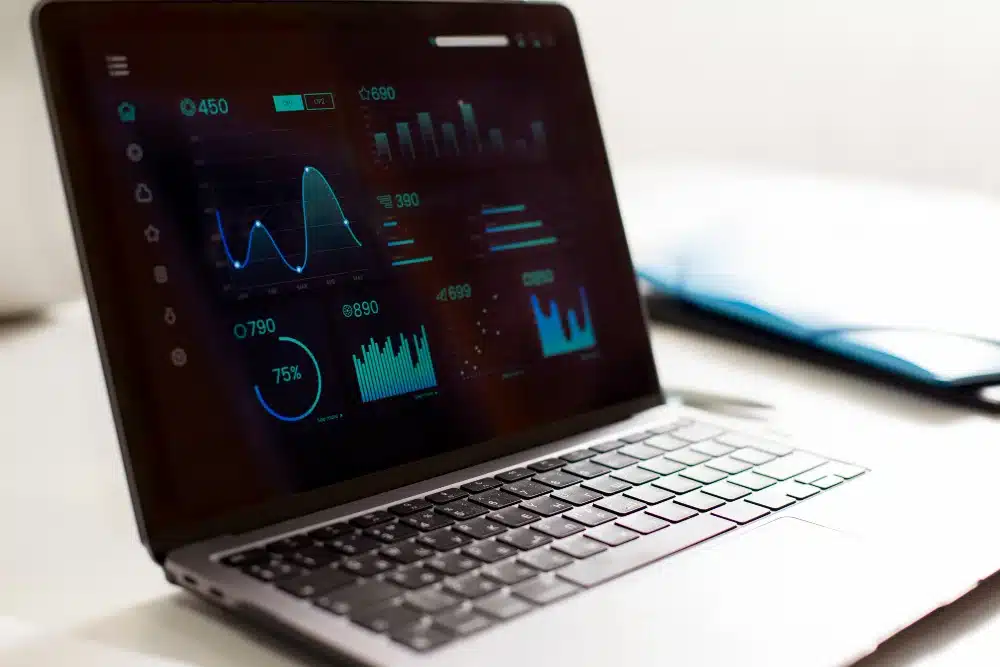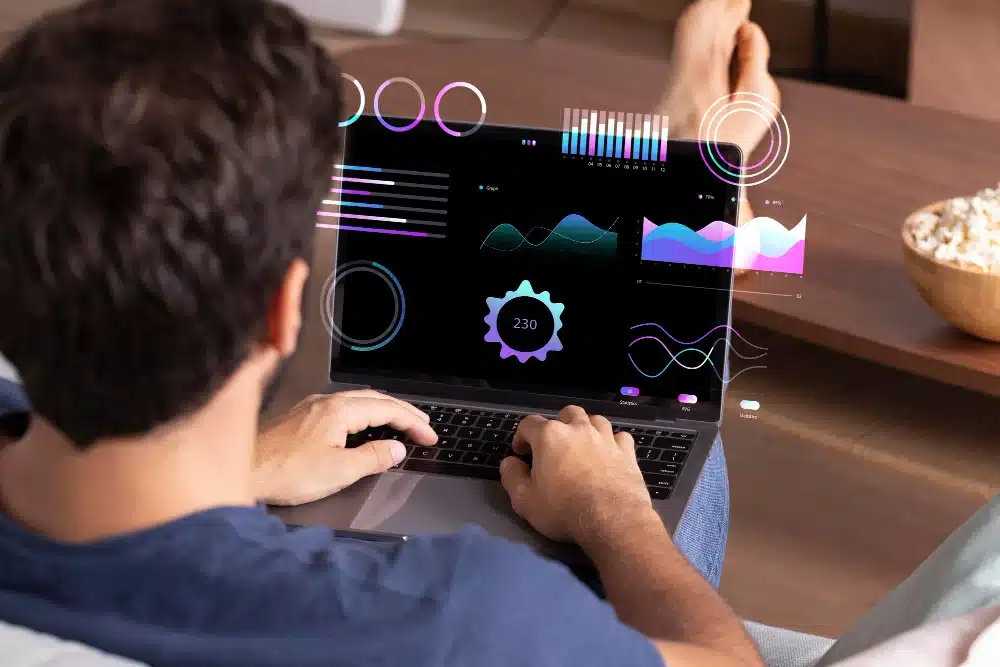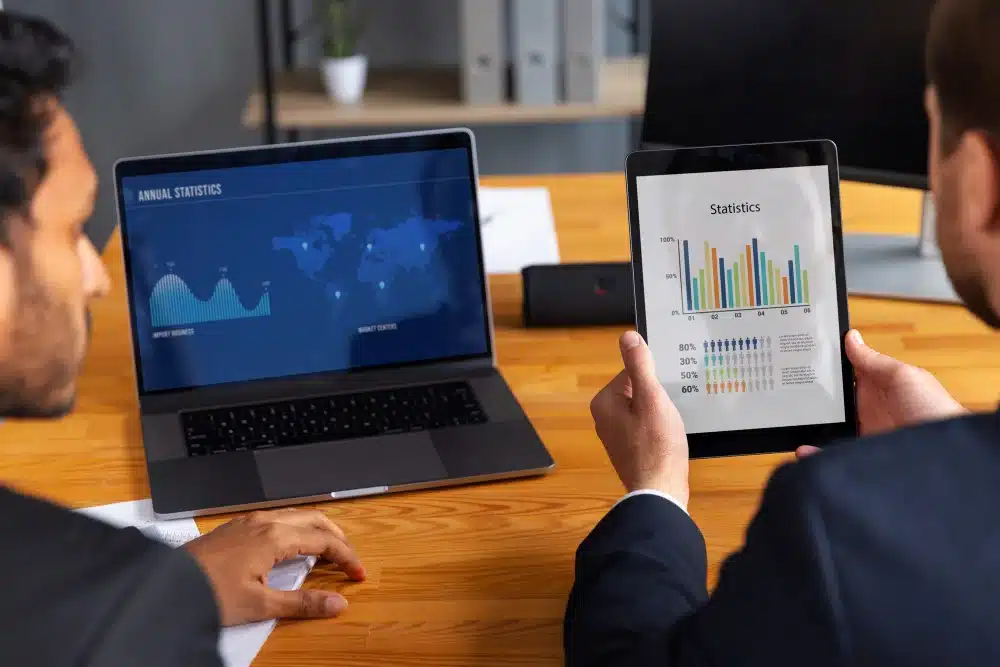Data often feels like a foreign language, a jumble of numbers and statistics that leave you scratching your head. But what if you could unlock the hidden stories within? The world of data visualization tools and trends is your space for transforming complex information into compelling visuals.
Turning raw information into useful insights is super important across different industries. However, nowadays, we’re bombarded with data from every direction. Making sense of it can feel like trying to navigate a maze blindfolded. That’s where data visualization comes in. It’s like turning on a light in that maze, illuminating the path forward and helping us make sense of the chaos.
In this landscape of data visualization, statistics play a pivotal role in shaping trends and methodologies. These data visualization statistics empower businesses to make informed decisions, driving growth and innovation. As a result, the demand for data visualization is growing daily. According to Mordor Intelligence, the global market size of data visualization will reach USD 16.54 Billion by 2029, almost double its current size, i.e. USD 9.84 Billion in 2024.
In this article, we’ll take a look at some of the cutting-edge tools driving innovation, what trends in data are, emerging technologies shaping the future, and real-life applications that demonstrate their power.
Unveiling the Secrets: Data Visualization Trends
Once a confusing mix of numbers and stats, data is now becoming a lively collection of stories waiting to be told. Data analysis trends lead this change, a field full of new ideas and exciting things happening. Let’s look at some of the big changes shaping this ever-changing field:
- Interactive Experiences
Remember boring charts in old reports? Now, data visualizations have ways to explore and find hidden info. Think about easily clicking through a big dataset or changing charts to see how things change in real time. Animated bits help show relationships and patterns in a way words can’t. This isn’t just for fun; it helps people get involved, understand better, and be part of finding info.
- Designing for Small Screens
In a world where we use phones a lot, data visualizations need to fit on tiny screens. Small screens need clear, short, and easy-to-touch stuff. You can swipe and tap picture charts, where it’s easy to see important stuff, even on a small screen. Also, social media-friendly formats help data stories reach more people and start conversations online.
- Using AI to Get Smarter Insights
AI and data visualization are becoming friends. AI is now helping with boring stuff like cleaning data or suggesting good ways to show it. AI can also find hidden patterns and ideas in big data sets, helping people learn more. This makes exploring new things easier and discovering more from data.
Example: AI algorithms empower businesses by swiftly identifying patterns and trends within extensive datasets, automating data-cleaning tasks, and recommending the most effective visualization techniques. This facilitates the seamless extraction of deeper insights, enabling companies to easily make informed decisions.
- 3D and Fun Experiences
One of the best trends in the data visualization space is three-dimensional projects. 3D data visualizations are new but cool. Imagine big datasets turned into fun, interactive worlds where you can walk around and explore. Virtual reality will make this even cooler, letting people dive into data like never before. This new trend is great for learning, playing, and finding new stuff in data.
These trends in data visualization reflect a dynamic landscape where innovation and technology intersect to reshape how we perceive and interact with data.
Discover the Latest Data Visualization Tools
From Tableau’s intuitive interface to D3.js’s creative flexibility, let’s explore the latest innovations shaping how we visualize and analyze data.
- Explore the World of Tableau
Tableau is a game changer in the field of data analysis. It is one of the most popular data visualization tools today. With its intuitive interface and powerful features, Tableau makes it easy for users to create stunning visualizations, analyze complex datasets, and share insights with others. Whether you’re a data analyst, business intelligence professional, or someone who loves data, Tableau has something to offer.
- Unlock Insights with Power BI
Microsoft Power BI is another powerhouse in the world of data visualization. With its seamless integration with other Microsoft products and services, Power BI makes it easy to connect to data sources and create compelling visualizations. Whether working on a small project or managing a large-scale enterprise deployment, Power BI has the tools you need to succeed.
- D3.js: Unleashing Creativity
D3.js is an open-source JavaScript library that empowers developers to create custom data visualizations from scratch. With its flexible architecture and extensive documentation, D3.js allows developers to unleash their creativity and build interactive, dynamic visualizations that push the boundaries of what’s possible.
Beyond Trends: Emerging Technologies Reshaping Data Visualization
While current trends offer a glimpse into the dynamic world of data visualization, several emerging technologies are ready to revolutionize the field and unlock even greater potential.
- Augmented Reality (AR) and Virtual Reality (VR)
Imagine overlaying interactive data visualizations onto real-world objects or immersing yourself within a 3D representation of your data. AR and VR technologies are blurring the lines between the physical and digital, creating novel ways to explore and interact with data.
For instance, architects view building plans superimposed on the construction site or surgeons rehearsing procedures within a VR simulation generated from medical scans. These immersive experiences promise enhanced understanding, improved decision-making, and personalized learning journeys.
- Mixed Reality (MR)
Merging the strengths of AR and VR, MR creates a hybrid environment where virtual elements seamlessly blend with the physical world. Imagine manipulating data visualizations alongside physical objects, such as manipulating 3D sales figures directly on a map or interacting with design prototypes in real-time. This interactive combination allows collaborative design, real-time data analysis, and intuitive data exploration.
- Haptic Technology
Adding the sense of touch to data visualization opens up new avenues for understanding. This multi-sensory approach goes beyond visual interpretation, allowing users to engage with data more intuitively. It is also one of the fastest-growing technology. According to MMR, the global haptic technology market will reach USD 6.61 billion by 2030 with a CAGR of 11%.
For example, the texture of a 3D-printed model generated from financial data or experiencing the vibrations of a climate change simulation through a haptic device
- Natural Language Processing (NLP)
Imagine asking your data visualization questions in plain English and receiving informative responses. NLP bridges the gap between human language and data, allowing for more intuitive interaction with visualizations. This technology can generate natural language descriptions of datasets, translate complex charts into easily understandable narratives, and even answer user queries directly from the visualization.
- Generative AI and Explainable AI
AI can now automatically generate data visualizations tailored to your specific needs and explain the reasoning behind its design choices. Generative AI pushes the boundaries of data visualization creation, while Explainable AI helps users understand the logic behind complex algorithms and models embedded within visualizations. This enhances trust, fosters critical thinking, and empowers users to make informed decisions based on data-driven insights.
These emerging technologies are still in their early stages of development, but they hold immense potential to transform how we interact with data.
Application of Data Visualization in Real-life.
Data visualization isn’t just a theoretical concept; it has real-world applications across diverse fields, impacting our daily lives in numerous ways. Here are some examples of good data visualization:
- Health and Medicine
From everyday fitness trackers meticulously logging daily steps to innovative apps providing detailed visualizations of sleep patterns, data visualization empowers individuals to comprehend and proactively manage their well-being. Moreover, data visualization is slowly becoming a part of the medical field.
For example, intricate 3D models derived from medical scans assist surgeons in meticulously planning complex procedures and enhance patient outcomes and recovery processes.
- Business and Finance
In commerce, businesses harness the power of interactive dashboards to closely monitor critical metrics such as sales trends, customer demographics, and the efficacy of marketing campaigns. Similarly, savvy investors utilize various charts and graphs to delve into stock market trends, compare company performance, and uncover promising investment opportunities.
- Government and Public Policy
Governments across the globe rely on data visualization to monitor public health trends, analyze resource allocation, and effectively communicate critical health risks to the public. Furthermore, interactive maps play a pivotal role in urban planning endeavors. They provide insightful visualizations of population density, traffic patterns, and the equitable distribution of resources.
- Everyday Life
In everyday life, animated weather maps offer detailed forecasts, allowing individuals to precisely plan their activities and engagements. Meanwhile, real-time traffic maps provide insightful visualizations of traffic congestion. Furthermore, sports enthusiasts and teams leverage data visualizations to analyze player performance, strategize effectively, and gain valuable insights into prevailing game trends and dynamics.
Also Read:- How Data Analytics Companies are Transforming the Digital World
Conclusion
In conclusion, data visualization isn’t just about making nice-looking charts. It’s a powerful tool for understanding complex data, telling compelling stories, and making a real impact. It is just the beginning; various other data visualization ideas have yet to settle down.
As the field keeps evolving, there’s a lot more to explore. That’s where an IT company can step in to help. With their expertise and experience, they can guide you through the world of data visualization, ensuring you get the most out of your data to drive success.
Frequently Asked Questions
When selecting a data visualization tool, consider your specific data requirements, visualization goals, available features, and budget. It’s also helpful to try different tools through free trials or demos to see which best suits your needs and preferences.
Some popular data visualization tools suitable for beginners include Tableau Public, Google Data Studio, Microsoft Power BI, Chart.js, and Datawrapper. These tools offer user-friendly interfaces, robust features, and ample resources for beginners to visualize their data effectively.
To stay updated on the latest developments in data visualization, you can follow industry blogs and attend webinars or conferences. Many data visualization tools and platforms also offer blogs, tutorials, and resources to help users stay informed about new features and updates.
















